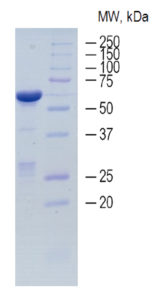SDS-PAGE: Protein was analysed in 12.5% SDS-PAGE with Coomassie blue staining.
Pan Plasmodium Aldolase Protein
Price range: $683.17 through $2,051.59 excl. VAT
This product is a recombinant Aldolase protein expressed and purified from E. coli with greater than 95% purity and can be used for developing ELISA and rapid test assays.
PAN PLASMODIUM ALDOLASE
Pan Plasmodium Aldolase Protein is a recombinant Aldolase protein expressed and purified from E. coli.Plasmodium falciparum and Plasmodium vivax have only one aldolase isoenzyme, which is highly conserved at the amino acid sequence and structural level, and is therefore used as one of the markers for diagnosis of malaria infection.
PRODUCT DETAILS – PAN PLASMODIUM ALDOLASE
- Pan Plasmodium aldolase protein, composed of the full length of the amino acid sequence of the P. falciparum aldolase (gene accession: AAA29716.1).
- Expressed in E. coli and purified by affinity chromatography. Migrates at ~66 kDa on SDS-PAGE and pI is 6.82.
- Presented in 10 mM Tris-HCl, pH 8.5, 10 mM NaCl.
- Can be used for immunoassay development.
BACKGROUND
Plasmodium falciparum Aldolase is composed of the full-length amino acid sequence of the P. falciparum Aldolase protein, which is cloned into the bacteria expression vector. The soluble recombinant protein is purified from E. coli with affinity chromatography to ≥95% purity.
P. falciparum Aldolase is a 41 kDa enzyme that binds to members of the thrombospondin-related anonymous protein (TRAP) family, including Actin and Adhesin. By doing so, Aldolase couples the actomyosin motor and cell surface adhesins involved in motility and host cell (Diaz et al., 2016) Aldolase also helps convert glucose into energy, making it critical for the intraerythrocytic merozoite life stage. Higher vertebrates usually have multiple tissue-specific aldolase isoenzymes. However, P. falciparum and P. vivax have only one aldolase isoenzyme, which is highly conserved at the amino acid sequence and structural level. Therefore, P. falciparum Aldolase is used as one of the markers for diagnosis of malaria infection.
Plasmodium falciparum is a unicellular protozoan parasite of humans, and causes the most dangerous form of malaria, with the highest rate of complications and mortality in humans. It is transmitted through the bite of female Anopheles mosquitos and is responsible for ~50% of all malaria cases worldwide. As a result, P. falciparum is regarded as the deadliest parasite in humans, causing 435,000 deaths in 2017 alone (WHO).
REFERENCES
- Diaz, S., Martin, S., Howell, S., Grainger, M., Moon, R., Green, J., Holder, A. (2016). The Binding of Plasmodium falciparum Adhesins and Erythrocyte Invasion Proteins to Aldolase Is Enhanced by Phosphorylation. PLoS One.
- World Health Organization. (2018). World Malaria Report 2018.


